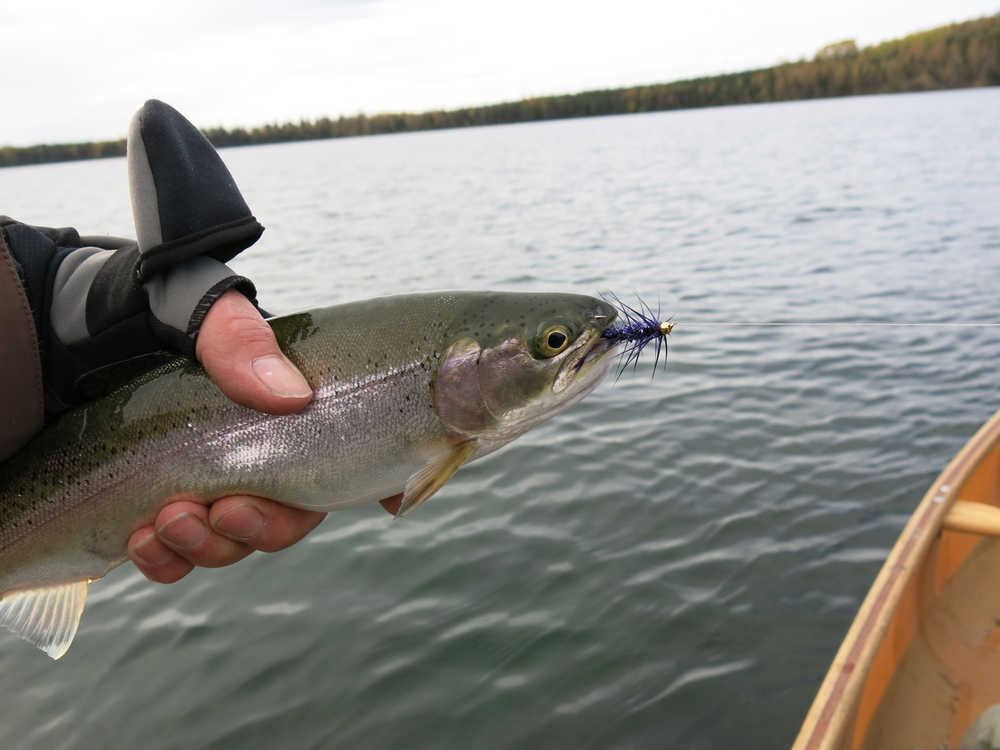The early spring weather, likely a symptom of climate change, has me, on the one hand, worried. As a homeowner it has me dreading another early fire season. As a fisherman it has me worried about warming stream temperatures and issues like ocean acidification, which may have dire effects upon our fisheries for generations.
On the other hand, the unseasonable spring weather has me excited about gearing up for fishing. I’m ready for lake fishing, and far earlier than normal. I’m also excited about hitting the Kenai River for trout before the river closes in May, and contemplating getting out on the saltwater sooner rather than later. Oh, the many options.
When I think of spring, my thoughts always jump to lake fishing. I began long ago making note of when the ice melted from our lower elevation lakes, like the pond behind my house and the lakes along Swanson River Road. For nearly 20 years, like clockwork, the ice went off on or around May 13. The last five years or so, it’s been a little earlier. Last year, in fact, the lakes were clear nearly a month early, allowing me to take a canoe trip into the Swan Lake system the first week in May, and this year the lakes have opened up even earlier.
Typically some of the best lake fishing occurs soon after ice-out, so making the best of it, I am getting my ultralight spinning gear and 3-weight fly rod ready for action. What’s nice about lake fishing is that just about any small variety of spinner or spoon (1/8 to 1/4 ounce) will do the trick. Those using spinning gear should also not be bashful about trying a large weighted fly, such as an egg-sucking leech, over weed beds. The best method for this is to attach a float or bobber far enough above the fly so that it sits just above the weeds. In most cases all that is required to entice a nice trout is the slightest movement, a mere twitch of the rod tip.
Fly fishers, along with a floating line and 10 foot leader, may also want to carry a sink-tip or full sinking line. These heavier lines are typically fished with a shorter leader of approximately 4 feet. Keep a large assortment of flies handy. Fish the surface with mayflies, midges and caddis, or dip below with your favorite streamer, Woolly Bugger, or leech.
With this warm weather it’s always tempting to get out on the Kenai and try for some trout. What I especially like this time of year is the variety of flies rainbow trout are likely to take. The warm weather will often induce a hatch of stone or caddis flies, and fishing with nymphs, either drifting them along the bottom or suspended in the water column, and even on a rare occasion using a dry fly on the surface, can be productive. If there isn’t any insect life stirring, there’s always the go-to: flesh flies mimicking last year’s salmon. As the water rises it reconstitutes last year’s carcasses and flesh becomes a major food source long before the latest generation of salmon show up. I also like taking a break from “dead drifting” flesh and egg patterns by swinging a leech through some of the deeper holes with a sinking line.
When I bought a saltwater boat several years ago, a guide friend of mine who fishes both the salt and fresh water asked if I was crazy. The way he described it was that being out on a river or a lake was 95 percent relaxing and 5 percent stressful, and being out on the salt was the other way around. He’s probably right, but I think that ratio would swing much more to the non-stressful column if I was simply out more. If I lived in Homer or Seward, for example, and had the boat in the harbor, the worry factor would be significantly less simply by virtue of being on the water so much more often. Half the stress comes from only being able to go out occasionally, thus having to remember everything — all the tools, the fishing gear, every safety device. It also comes from having to tow the boat long distances and dealing with launching at an often crowded harbor. I actually contemplated selling the boat and had it briefly listed, but then spent a couple nights just outside of Resurrection Bay fishing for silver salmon and rockfish.
Humpback whales were swimming around us all night. We could hear them rise and take a breath right next to us, then feel the slight sway of the boat on anchor, rolling in their gentle wake; all the while the northern lights painted the night sky in broad strokes of green and crimson. It was truly magical and reminded me of something basic, a power primordial and raw that one only experiences at sea, among the windswept cliffs of the outer coast. In this case, the payoff was definitely worth all the trouble.
Needless to say, after that I knew I had to keep the boat. It is just a matter of getting out more. But there’s the rub. With all the fishing available, from lakes to streams to open ocean, and with only a limited matter of time, how does one ever decide which option to take?
Dave Atcheson’s latest book is “Dead Reckoning, Navigating a Life on the Last Frontier, Courting Tragedy on its High Seas.” He is also the author of the guidebook “Fishing Alaska’s Kenai Peninsula,” and National Geographic’s “Hidden Alaska, Bristol Bay and Beyond.” For more info: www.daveatcheson.com.
■ ■ ■
Tight Lines is a regular feature of the Peninsula Clarion. It will return on a weekly basis starting May 26 with fishing reports and other information.
Have a favorite fishing photo, tale or recipe? Share it with our readers. Email tightlines@peninsulaclarion.com.

